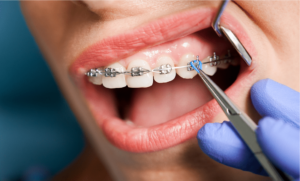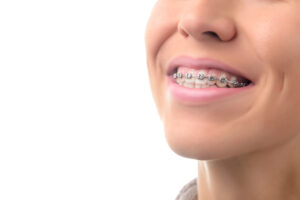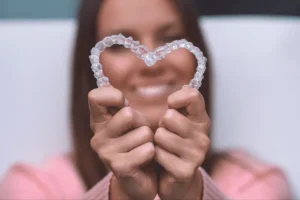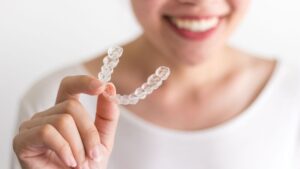
Many people, especially children and teenagers, don’t floss or brush their teeth frequently. Every time you give up your oral hygiene habits, you increase your risk of cavities or cavities from braces. When wearing braces, you need to be very careful with your oral hygiene. Most people imagine a beautiful smile after removing braces, but not cavities and decay. Oral hygiene habits of wearing braces can destroy cavities and some of your teeth.
No one wants to have their teeth in braces for a long period of time, only to be welcomed with decay when they remove the braces. This is why oral hygiene is so important. Cavities develop quickly and can occur where braces are placed between the teeth because flossing becomes much more difficult.
If you are looking for orthodontic services in Riverside, it’s crucial to find a reputable orthodontist who can provide the necessary care and guidance for your braces journey. Proper orthodontic treatment in Riverside can help ensure that your teeth and oral health are well taken care of while wearing braces. Regular visits to an orthodontist in Riverside will allow them to monitor your progress, make any necessary adjustments, and provide guidance on maintaining good oral hygiene during your orthodontic treatment.
CAN BRACES CAUSE TOOTH DECAY?
Many people are hesitant to get traditional braces or do not even consider them for fear that braces can cause cavities. Most times, the food you consume gets stuck between your teeth, this predisposes to decay in your teeth. Braces by themselves cannot cause cavities. However, they increase the chances of plaque and cavities. This is why we hear more cavities from people with braces than from people without braces.
Depending on the type of braces you wear, braces can filter food and sugar residues from certain beverages. Once trapped, these food/beverage particles cause bacteria to accumulate. Bacteria from plaque. The build-up of plaque causes tooth decay (or tooth decay) and gum disease.
You are more likely to experience this problem with fixed braces made of metal, ceramic, or plastic. However, removable braces can also cause tooth decay. If left untreated, cavities can infect the pulp of your teeth. Tooth decay can soon develop into a painful abscess, infection, or jaw problem. This is why it’s so important to put more effort into keeping your braces clean to prevent cavities.
WHAT ARE THE SIGNS OF TOOTH DECAY?
There are several symptoms that indicate you have tooth decay. These include:
- Severe Toothache
Persistent pain in one or more teeth may indicate tooth decay. In fact, pain is one of the most common symptoms of tooth decay. Sometimes this pain may appear suddenly or as a result of eating. This includes pain and discomfort in or around the mouth. You may also feel pain and pressure when chewing food.
- Increased sensitivity to hot and cold food
Sensitivity that persists after eating hot or cold food may be a sign of tooth decay. When the tooth’s enamel begins to wear, it can affect the dentin, the hard tissue layer beneath the enamel. Dentin is made up of many microscopic hollow tubes.
Hot, cold, sticky, or acidic foods can irritate the cells and nerves inside the teeth when there is not enough enamel to protect the dentin. This is what creates the sensitivity you feel.
- Holes in the teeth
You may see holes in your teeth with tooth decay. Some holes, especially between teeth or crevices, cannot be seen or felt. However, you may still feel pain or tenderness in the area. If you find a hole or hole in your tooth, make an appointment with your dentist. This is an obvious sign of tooth decay.
- Stains on the teeth
Teeth stains may initially appear as white spots. As tooth decay progresses, the stain may thicken. Dental cavities staining can be brown, black, or white and usually appears on the tooth surface.
WHAT HAPPENS IF YOU HAVE TOOTH DECAY WITH BRACES?
If you have tooth decay with braces, it can be treated.
With braces, treatment is a little more difficult but possible. Usually, tooth decay occurs between cracks in the teeth, around braces, and wires. If you have severe tooth decay, your dentist may remove the wire so that the condition can be properly treated.
Severe tooth decay may require the removal of brackets from teeth if they interfere with dental care. This is only done in certain cases, and the missing part is replaced as soon as possible to prevent the tooth from moving.
HOW DO YOU PREVENT TOOTH DECAY WITH BRACES
Braces can trap food particles. If not removed properly, sticky dirt, bacteria and plaque can build up on your teeth and gums. This can lead to tooth decay. Below are some great dental hygiene practices that can help prevent tooth decay;
- Responsible Nutrition with Braces
For corrections, such as tightening braces, it is important to visit your orthodontist for regular check-ups. In particular, children are prone to cavities and discolouration because they do not brush or floss properly during orthodontic treatment. In these cases, the orthodontist can examine the inside of the mouth to prevent decay.
- Brushing and Flossing Regularly
Good oral hygiene requires breaking away from your dental routine and becoming more familiar with your brushing habits. Plaque can be hidden in staples and wires that are not easy to remove. Lack of proper dental care with braces in riverside can worsen plaque formation and lead to tooth decay.
- Brushing After Every Meal
Eating the wrong kinds of food can damage your teeth braces and result in tooth decay. Things like hard nuts, pretzels, jellies, and chewing ice are what you should avoid eating. Another good tip is to be sure you cut up your fruits and vegetables into bite-size pieces and just put them into your mouth instead of biting into them. Also, avoid sticky and chewy foods like caramel chocolates, gummy bears, and gums. These types of foods can and will damage or break your braces which can add time to your treatment, which means you could have your braces on longer than estimated.
There are also a lot of great things that are okay to eat while wearing dental braces. Softer foods like fruits are okay to eat and are good for you too.
Brushing your teeth after each meal will go a long way in preventing tooth decay because the food chances of food particles getting stuck reduce significantly.
FAQ
Q: How to know if you have a cavity with braces?
A: Monitoring for cavities is crucial when wearing braces. Look out for signs such as tooth sensitivity, pain, or discomfort while biting or chewing, visible dark spots or holes on your teeth, and swollen or bleeding gums. Regular dental check-ups and professional examinations are essential to detect cavities early.
Q: What happens if you get a cavity with braces?
A: If you develop a cavity while wearing braces, it’s important to address it promptly. The braces may complicate the treatment process, but your orthodontist can work with your dentist to devise a suitable plan. Treatment may involve temporarily removing the affected bracket or wire to access and fill the cavity. Maintaining excellent oral hygiene and following the recommended dental care routine is vital to prevent further decay.
Q: How to tell if you have a cavity with braces?
A: Detecting a cavity with braces requires vigilance. Look for signs like increased tooth sensitivity, persistent pain, a chalky or discoloured spot around the brackets, or difficulty cleaning certain areas due to braces. Regularly inspect your teeth in a well-lit area using a mirror. If you suspect a cavity, promptly schedule a dental appointment for an accurate diagnosis and appropriate treatment options.
Contact Us
Conveniently located in Riverside, we serve patients of all ages in the surrounding areas. We pride ourselves on creating a warm and welcoming environment, making your visits to our office a pleasant experience.
Ready to take the first step towards a healthier, more confident smile? Contact Riverside Orthodontics today to schedule your consultation. Our dedicated team is excited to meet you, answer your questions, and start you on the journey to a stunning smile. Call us now or visit our website to book your appointment. We look forward to welcoming you to our practice!




